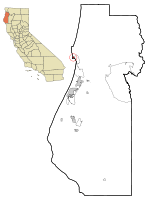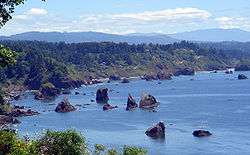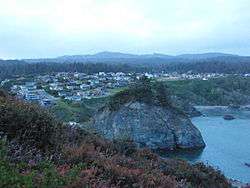Trinidad, California
Trinidad (Yurok: Chuerey) is a seaside city in Humboldt County, located on the Pacific Ocean 8 miles (13 km) north of the Arcata-Eureka Airport and 15 miles (24 km) north of the college town of Arcata. Situated at an elevation of 174 feet (53 m) above its own North Coast harbor, Trinidad is one of California's smallest incorporated cities[6] by population (367 residents in 2010, up from 311 residents in 2000). Trinidad is noted for its spectacular coastline with ten public beaches and offshore rocks, part of the California Coastal National Monument, of which Trinidad is a Gateway City.[7] Fishing operations related to Trinidad Harbor are vital to both local tourism and commercial fishery interests in the region.
Trinidad, California | |
|---|---|
City | |
 A view of Trinidad from a trail on nearby Trinidad Head | |
 Location in Humboldt County and the state of California | |
 Trinidad Coastline South; CCNM | |
 Trinidad Location in the United States  Trinidad Trinidad (California)  Trinidad Trinidad (the United States) | |
| Coordinates: 41°03′33″N 124°08′35″W | |
| Country | |
| State | |
| County | Humboldt |
| Incorporated | November 7, 1870[1] |
| Government | |
| • Type | Council-Manager Government |
| Area | |
| • Total | 0.67 sq mi (1.74 km2) |
| • Land | 0.48 sq mi (1.26 km2) |
| • Water | 0.19 sq mi (0.48 km2) 27.75% |
| Elevation | 174 ft (53 m) |
| Population (2010) | |
| • Total | 367 |
| • Estimate (2019)[4] | 355 |
| • Density | 731.96/sq mi (282.68/km2) |
| Time zone | UTC-8 (Pacific (PST)) |
| • Summer (DST) | UTC-7 (PDT) |
| ZIP code | 95570 |
| Area code(s) | 707 |
| FIPS code | 06-80448 |
| GNIS feature IDs | 1660029, 2412093 |
| Website | www |
| Reference no. | 216[5] |
History

Before 1700 AD, Yurok people established the village of Tsurai on bluffs overlooking Trinidad Bay. The first European sighting of Trinidad Harbor was by the Manila galleon captain Sebastian Rodriguez Cermeño, who did not make landfall. The next visit was by Bruno de Heceta and Juan Francisco de la Bodega y Quadra of the Spanish Navy. Their two ships anchored in Trinidad Bay on June 9, 1775. On 11 June, which was Trinity Sunday, a formal act of possession was conducted.[8] At the place where a wooden cross was erected stands a carved stone cross bearing the inscription. Carolus III Dei G. Hyspaniorum Rex., in the name of King Carlos of Spain.[9] The area was named "la Santisima Trinidad".
Settlers arrived on the James R. Whitting in 1850 and founded the town, renamed Warnersville in honor of R.V. Warner, one of the settlers.[10] The first post office opened in Trinidad in 1851.[10]
Trinidad was the original county seat of the eponymous Trinity County from 1850 to 1851, and of Klamath County, one of California's original counties, from 1851 to 1854. At that time Trinidad became part of the newly created Humboldt County after its creation in 1853, with its county seat in Eureka. Klamath County was finally dissolved in 1874.
During the American Civil War, from July to October 1863, California volunteers fighting the local Indians in the Bald Hills War were stationed in the town, in Trinidad Camp, to protect it and the coast road from Indian raids, until they were moved four miles north to Camp Gilmore.[11] Trinidad was incorporated in 1870 as a City of the State of California, USA.[12]
Trinidad resident Henry A. Boyes was a first sergeant with the 5th Marines in World War II; his service was described by Eugene Sledge in the book, With the Old Breed: At Peleliu and Okinawa.[13]
Pop Culture Reference
Part of the auto wreck scene in The Majestic was shot at College Cove Beach on 19 March 2001.[14]
Geography
Climate
Trinidad has an oceanic climate, bordering on a warm-summer Mediterranean climate (csb) and is relatively temperate compared with inland areas.[15] Annual temperatures range from approximately 37.1 °F (2.8 °C) to 74.2 °F (23.4 °C). Winter months are rainy with the average amount being around 50 inches (130 cm),[16] Although rain falls in all months of the year, it is less pronounced in the summertime.[15] Spring and fall cold fronts often form advection fog which pushes the marine layer towards the coast. In summer, low pressure troughs produced by intense heating inland can create strong pressure gradients pulling the marine layer ashore.[15] Summer fogs, moderate precipitation, and mild temperatures are characteristic of Northern California coastal forests ecoregion and are vital to the growth of local Coast Redwood.[17] Protected stands of old growth redwoods can be visited 20 miles (32 km) north of Trinidad, in Redwood National and State Parks.
| Climate data for Trinidad, California | |||||||||||||
|---|---|---|---|---|---|---|---|---|---|---|---|---|---|
| Month | Jan | Feb | Mar | Apr | May | Jun | Jul | Aug | Sep | Oct | Nov | Dec | Year |
| Average high °F (°C) | 53.6 (12.0) |
55.4 (13.0) |
58.0 (14.4) |
61.1 (16.2) |
65.3 (18.5) |
69.5 (20.8) |
73.7 (23.2) |
74.2 (23.4) |
72.5 (22.5) |
66.6 (19.2) |
57.3 (14.1) |
52.2 (11.2) |
63.3 (17.4) |
| Daily mean °F (°C) | 45.4 (7.4) |
46.6 (8.1) |
48.4 (9.1) |
50.8 (10.4) |
54.7 (12.6) |
58.6 (14.8) |
62.1 (16.7) |
62.4 (16.9) |
59.7 (15.4) |
54.9 (12.7) |
48.8 (9.3) |
44.7 (7.1) |
53.1 (11.7) |
| Average low °F (°C) | 37.2 (2.9) |
37.7 (3.2) |
38.8 (3.8) |
40.4 (4.7) |
44.0 (6.7) |
47.6 (8.7) |
50.5 (10.3) |
50.4 (10.2) |
46.8 (8.2) |
43.1 (6.2) |
40.2 (4.6) |
37.1 (2.8) |
42.8 (6.0) |
| Average precipitation inches (mm) | 9.3 (240) |
7.7 (200) |
7.2 (180) |
4.5 (110) |
2.8 (71) |
1.3 (33) |
0.3 (7.6) |
0.4 (10) |
0.9 (23) |
3.2 (81) |
7.6 (190) |
10.6 (270) |
55.8 (1,415.6) |
| Average snowfall inches (cm) | 0.2 (0.51) |
0.6 (1.5) |
0.2 (0.51) |
0 (0) |
0 (0) |
0 (0) |
0 (0) |
0 (0) |
0 (0) |
0 (0) |
0 (0) |
0.4 (1.0) |
1.4 (3.52) |
| Average rainy days | 16.3 | 14.6 | 16.3 | 12.8 | 9.0 | 5.0 | 2.2 | 2.8 | 4.2 | 8.2 | 15.6 | 17.3 | 124.3 |
| Average snowy days | 0.2 | 0.3 | 0.2 | 0 | 0 | 0 | 0 | 0 | 0 | 0 | 0 | 0.3 | 1 |
| Source: [18] | |||||||||||||
Demographics
| Historical population | |||
|---|---|---|---|
| Census | Pop. | %± | |
| 1880 | 104 | — | |
| 1930 | 107 | — | |
| 1940 | 94 | −12.1% | |
| 1950 | 188 | 100.0% | |
| 1960 | 289 | 53.7% | |
| 1970 | 300 | 3.8% | |
| 1980 | 379 | 26.3% | |
| 1990 | 362 | −4.5% | |
| 2000 | 311 | −14.1% | |
| 2010 | 367 | 18.0% | |
| Est. 2019 | 355 | [4] | −3.3% |
| U.S. Decennial Census[19] | |||

2010 Census data
The 2010 United States Census[20] reported that Trinidad had a population of 367. The population density was 547.1 people per square mile (211.2/km2). The racial makeup of Trinidad was 331 (90.2%) White, 2 (0.5%) African American, 15 (4.1%) Native American, 2 (0.5%) Asian, 1 (0.3%) Pacific Islander, 1 (0.3%) from other races, and 15 (4.1%) from two or more races. Hispanic or Latino of any race were 11 persons (3.0%).
The Census reported that 366 people (99.7% of the population) lived in households, 1 (0.3%) lived in non-institutionalized group quarters, and 0 (0%) were institutionalized. There were 187 households, out of which 35 (18.7%) had children under the age of 18 living in them, 64 (34.2%) were opposite-sex married couples living together, 21 (11.2%) had a female householder with no husband present, 3 (1.6%) had a male householder with no wife present. There were 20 (10.7%) unmarried opposite-sex partnerships, and 3 (1.6%) same-sex married couples or partnerships. 73 households (39.0%) were made up of individuals and 28 (15.0%) had someone living alone who was 65 years of age or older. The average household size was 1.96. There were 88 families (47.1% of all households); the average family size was 2.64.
The population dispersal was 60 people (16.3%) under the age of 18, 25 people (6.8%) aged 18 to 24, 91 people (24.8%) aged 25 to 44, 120 people (32.7%) aged 45 to 64, and 71 people (19.3%) who were 65 years of age or older. The median age was 45.9 years. For every 100 females, there were 98.4 males. For every 100 females age 18 and over, there were 98.1 males. There were 252 housing units at an average density of 375.7 per square mile (145.0/km2), of which 187 were occupied, of which 113 (60.4%) were owner-occupied, and 74 (39.6%) were occupied by renters. The homeowner vacancy rate was 4.2%; the rental vacancy rate was 12.9%. 212 people (57.8% of the population) lived in owner-occupied housing units and 154 people (42.0%) lived in rental housing units.
2000 Census data
As of the census[21] of 2000, there were 311 people, 168 households, and 73 families residing in the city. The population density was 643.0 people per square mile (250.2/km2). There were 228 housing units at an average density of 471.4 per square mile (183.4/km2). The racial makeup of the city was 94.86% White, 1.61% Black or African American, 0.32% Native American, 0.64% Asian, 0.32% Pacific Islander, 0.32% from other races, and 1.93% from two or more races. 2.25% of the population were Hispanic or Latino of any race. There were 168 households out of which 12.5% had children under the age of 18 living with them, 36.9% were married couples living together, 5.4% had a female householder with no husband present, and 56.5% were non-families. 40.5% of all households were made up of individuals and 11.9% had someone living alone who was 65 years of age or older. The average household size was 1.85 and the average family size was 2.51.
In the city, the population dispersal was 11.3% under the age of 18, 5.5% from 18 to 24, 21.9% from 25 to 44, 41.5% from 45 to 64, and 19.9% who were 65 years of age or older. The median age was 50 years. For every 100 females, there were 98.1 males. For every 100 females age 18 and over, there were 100.0 males. The median income for a household in the city was $40,000, and the median income for a family was $50,357. Males had a median income of $39,583 versus $31,167 for females. The per capita income for the city was $28,050. About 2.3% of families and 8.8% of the population were below the poverty line, including 6.7% of those under age 18 and none of those age 65 or over.
Politics
In the state legislature, Trinidad is in the 2nd Senate District, represented by Democrat Mike McGuire,[22] and the 2nd Assembly District, represented by Democrat Jim Wood.[23]
Federally, Trinidad is in California's 2nd congressional district, represented by Democrat Jared Huffman.[24]
Points of interest

State parks
Historic landmarks
- Trinidad Head Light, National Registered Landmark #1720
- Trinidad Head, State Historic Landmark #146
- Town of Trinidad, State Historic Landmark #216
- Old Indian Village of Tsurai, State Historic Landmark #838
Other
- Trinidad Pier
- Strawberry Rock
- Fred Telonicher Marine Laboratory, Humboldt State University
- Trinidad City Cemetery includes Indian and settler graves and one unusual tombstone. Edward Bernhardt Schnaubelt was the brother of Rudolph Schnaubelt, accused of the Haymarket Riot bombing in Chicago, Illinois and the brother-in-law of Michael Schwab, sentenced to death for his role in the riot. All three Schnaubelt brothers left Chicago shortly after the riot. Edward Schnaubelt briefly panned for gold before settling in Trinidad, opening a sawmill and buying a tract of timber to supply his mill. After Schnaubelt's mill was taken over by his rivals, he re-entered the closed mill at night to reclaim his personal tools, and was shot to death by a nightwatchman hired to protect the property. His wife chose the phrase "Murdered by Capitalism" for his marker which inspired the 2004 book by John Ross.[25]
 Edward Bernhardt Schnaubelt's tombstone in the Trinidad Cemetery
Edward Bernhardt Schnaubelt's tombstone in the Trinidad Cemetery
Events
- Trinidad to Clam Beach Run (February)
- Trinidad Fish Festival (June)
- Tour of Trinidad bicycle rides, 100k, 45k,20k (September)
- Blessing of the Fleet (November)
Notable residents
- Robert Durst - real estate scion, former Trinidad homeowner
- Michael John Fles - poet and musician
- Howard B. Keck - businessman
- Tim McKay - environmental activist
- Thomas Pynchon - author, lived in Trinidad during 1976–77[26]
- Don Van Vliet aka Captain Beefheart – musician and painter
- Al Vermeer – cartoonist, creator of comic strip Priscilla's Pop[27]
References
- "California Cities by Incorporation Date". California Association of Local Agency Formation Commissions. Archived from the original (Word) on November 3, 2014. Retrieved April 7, 2013.
- "2019 U.S. Gazetteer Files". United States Census Bureau. Retrieved July 1, 2020.
- "Trinidad". Geographic Names Information System. United States Geological Survey.
- "Population and Housing Unit Estimates". United States Census Bureau. May 24, 2020. Retrieved May 27, 2020.
- "Trinidad". Office of Historic Preservation, California State Parks. Retrieved October 7, 2012.
- Sims, Hank (October 27, 2003). "Town Is on Brink Over Trail at Sea's Edge". Los Angeles Times.
- Bureau of Land Management. "Trinidad Gateway". Monument Brochures. Archived from the original on October 13, 2012. Retrieved December 3, 2012.
- Tovell, Freeman M. (2008). At the Far Reaches of Empire: The Life of Juan Francisco De La Bodega Y Quadra. University of British Columbia Press. pp. 22–23. ISBN 978-0-7748-1367-9. Retrieved December 3, 2012.
- Tovell, Freeman M. (2008). At the Far Reaches of Empire: The Life of Juan Francisco De La Bodega Y Quadra. University of British Columbia Press. pp. 22–23. ISBN 978-0-7748-1367-9.
- Durham, David L. (1998). California's Geographic Names: A Gazetteer of Historic and Modern Names of the State. Clovis, Calif.: Word Dancer Press. p. 159. ISBN 1-884995-14-4.
- Historic California Posts:Trinidad Camp, The California State Military Museum, accessed 3 December 2012
- City of Trinidad Website http://www.trinidad.ca.gov accessed 3 December 2012
- Sledge, Eugene, With the Old Breed: At Peleliu and Okinawa, 1981, Presidio Press, Novato, California, OCLC 12197607, p. 213
- Film in America, The Majestic accessed 3 December 2012 Archived May 13, 2012, at the Wayback Machine
- "About Humboldt County: Geography". Humboldt County, California. Retrieved May 25, 2011.
- "Trinidad, California". City Data. City Data website. Retrieved May 25, 2011.
- Jebens, Brandon (Fall 1999). "The Biogeography of Sequoia sempervirens". Student Paper, Geography 316: Biogeography. San Francisco State University Department of Geography. Archived from the original on April 11, 2011. Retrieved May 25, 2011.
- "Trinidad, California". Retrieved July 19, 2020.
- "Census of Population and Housing". Census.gov. Retrieved June 4, 2015.
- "2010 Census Interactive Population Search: CA - Trinidad city". U.S. Census Bureau. Archived from the original on July 15, 2014. Retrieved July 12, 2014.
- "U.S. Census website". United States Census Bureau. Retrieved January 31, 2008.
- "Senators". State of California. Retrieved March 10, 2013.
- "Members Assembly". State of California. Retrieved March 2, 2013.
- "California's 2nd Congressional District - Representatives & District Map". Civic Impulse, LLC. Retrieved March 1, 2013.
- Ross, John (June 2004). Murdered by capitalism: a memoir of 150 years of life and death on the American left. Avalon Publishing Group. p. 400. ISBN 978-1-56025-578-9. Retrieved December 3, 2012.
- Kachka, Boris (August 25, 2013). "On the Thomas Pynchon Trail: From the Long Island of His Boyhood to the 'Yupper West Side' of His New Novel". New York magazine. Retrieved May 18, 2015.
- "Cartoonist Al Vermeer dies following stroke". Eureka Times-Standard. November 28, 1980. Retrieved January 24, 2017.
External links
| Wikimedia Commons has media related to Trinidad, California. |
Government and Public Community Information
- Official website

- Greater Trinidad Chamber of Commerce official website
- Trinidad Tourism and Lodging Association official website - Stay in Trinidad!
- California Coastal National Monument Gateway City of Trinidad official webpage
- NOAA: local radar and weather
Individual and Private Community Information
